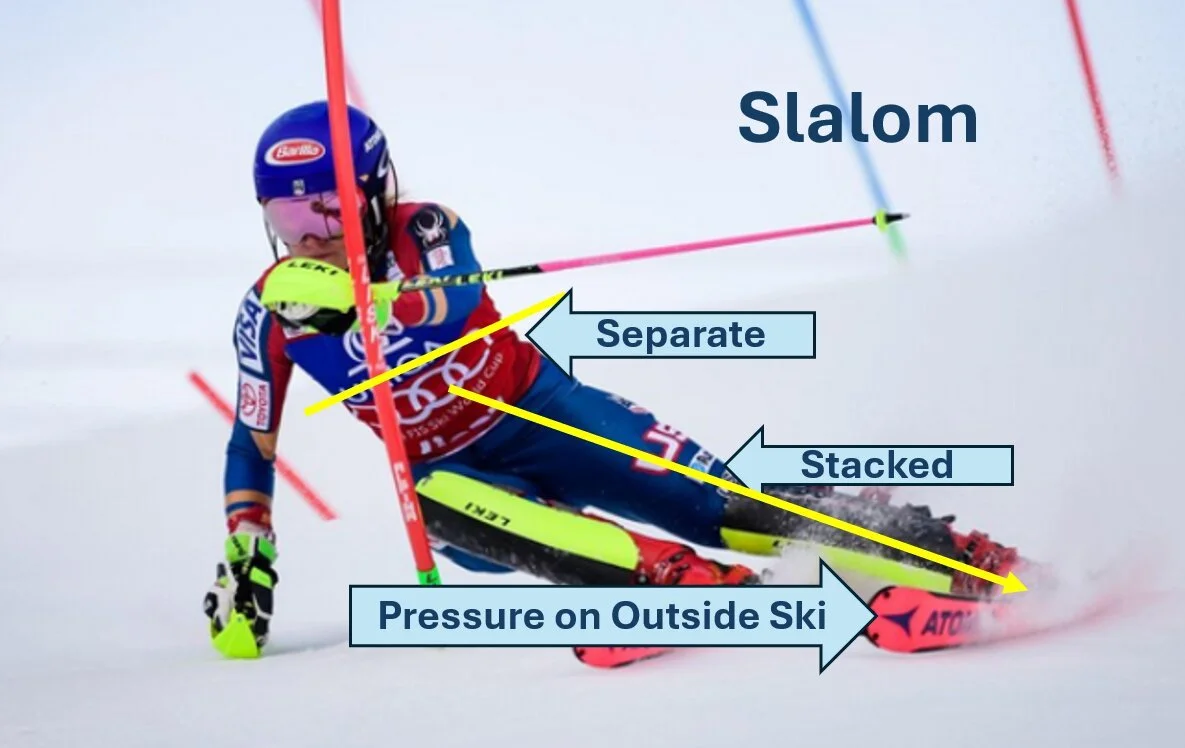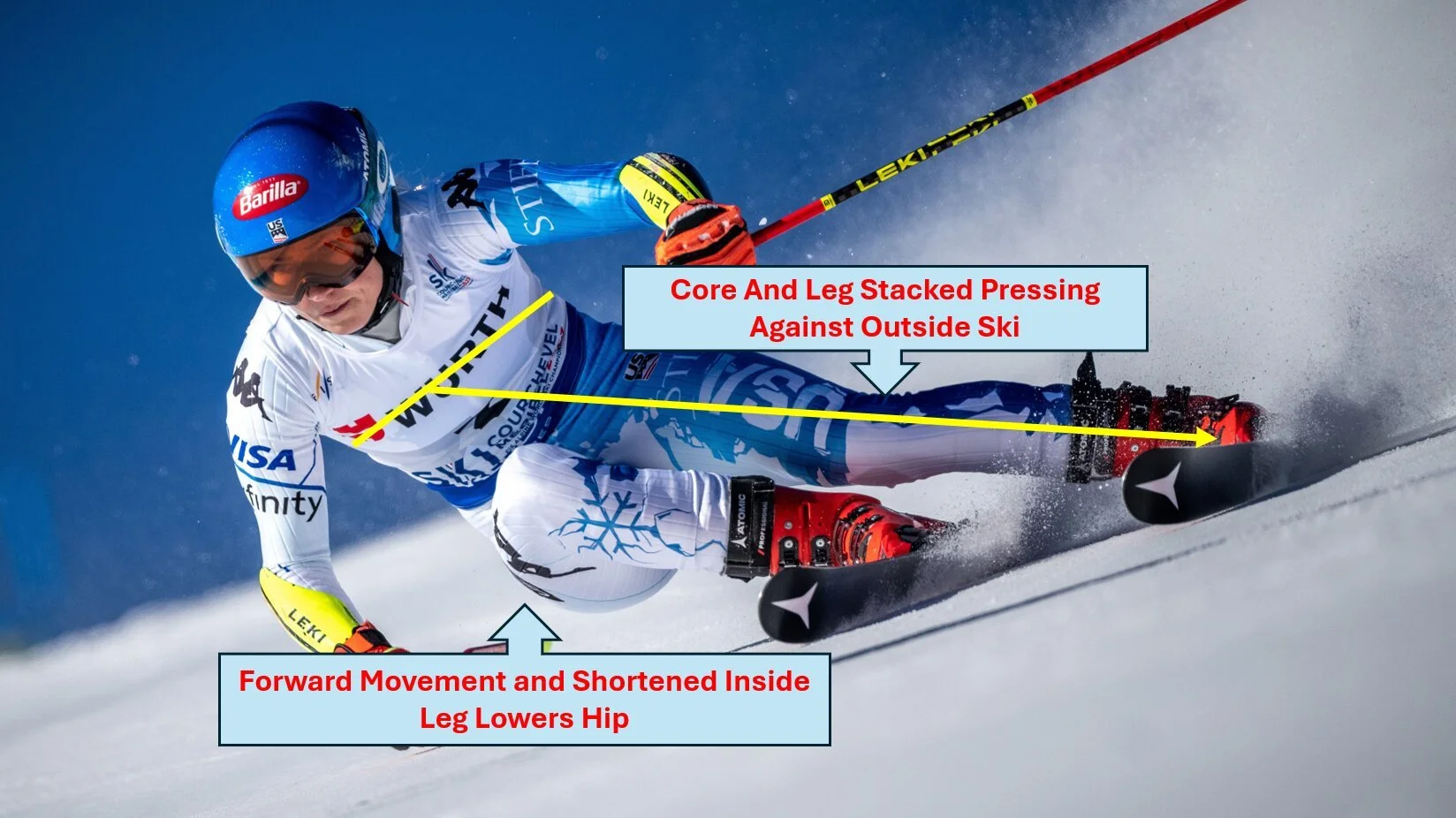Stack, Separate and Press
M. Odermatt/L.M.P. Group/Alamy
Overview
Movement 5: Stack your outside leg and core keeping your shoulders level to the snow by separating just below the shoulders, and press your foot against the outside ski.
This description is the fifth of eight modules included in the Ski Technique module, describing how elite skiers and racers carve turns.
The outside leg is biomechanically strong when the ankle, leg, hips, and core are aligned and stacked on top of one another and pressing against the outside ski.
John Leffler, the well known U.S.A. race coach, demonstrates how to stack the body and separate just below the shoulders in this video. Watch for about a minute from where this video starts, until Leffler begins talking about gravity.
Video by Deb Armstrong and Ski Strong
Marco Odermatt and Mikaela Shiffrin stack their bodies against their outside skis, keeping their shoulders mostly level with the snow in the following images.
M. Odermatt/Image by /L.M.P. Group/Alamy/Graphics by ARM
Shiffrin/ Image by J. Makovec/Alamy/Graphics by ARM
How to Separate Below the Shoulders
Level the shoulders to prevent the body leaning away from the outside ski. This action will cause the body to “Separate”.
To feel where to Separate, place your hands against your rib cage just below your shoulders. Lower one elbow then the other and you will feel how the shoulders can tip side to side or Separate.
Image by ARM
Press and Resist
When carving a turn an objective is to have all your pressure against the outside ski with no pressure on the inside ski.
The stacked leg presses firmly against the outside ski through the arch of the foot, and by resisting the forces pushing back, causes the ski to bend, carve, and accelerate. Keep your shins flexed forward against the tongues or cuffs of both boots.
Pushing too aggressively, can release the energy from the ski and reduce the duration of the carving action.
Do not ‘Drop Your Hip’!
Avoid separating at the waist and dropping your hip toward the snow. This action breaks the stacking of the core and outside leg, shifts pressure onto the inside ski, and reduces pressure on the outside ski, limiting its ability to carve, bend and accelerate.
Dropping the hip also increases the risk of injury—racers who use this technique are often injured, sometimes seriously, when skiing on racecourses with steep, icy, or rough conditions.
The illusion of ‘Dropping the Hip’
While it may seem that Mikaela Shiffrin is separating at the waist to ‘drop her inside hip to the snow’ in the image below, this is merely an illusion.
In reality, she is moving forward and inside the turn, stacking her core and outside leg, and shortening her inside leg to create a higher edge angle and increased pressure on the outside ski.
As a natural consequence of these movements, her hip moves lower to the snow rather than as a deliberate action.
Shiffrin/Image M. Kappeler/DPA PA/Alamy
Watch this racer stack his core over his outside leg while keeping his shoulders mostly level, in this video.
Video by Shred.Riders
Coach’s Tip: Avoid trying to make your outside leg long, straight, or extended. Here’s why:
When starting a new turn in an athletic stance while maintaining ankle flexion, the outside leg remains the same length.
The inside leg shortens naturally due to the slope of the hill or by actively lifting the heel, making the outside leg appear longer.
Key Takeaways
Stacking for Alignment: Strength and stability in skiing are maximized when the ankle, leg, hips, core, and shoulders are stacked in alignment.
Separation for Balance: Separating just below the shoulders helps prevent the upper body from leaning away from the outside ski, maintaining balance and control.
Press and Resist: Applying pressure against the outside ski is critical for carving. A stacked outside leg resists pressures pushing back against the foot, causing the ski to bend, carve and accelerate.
Suggested Learning Modules
Go to Ski Technique 6. Shorten the Inside Leg
Return to Ski Technique
Important Message: Skiing and ski racing involve inherent risks. It’s essential to ski responsibly and stay within your skill level and personal comfort limits.





